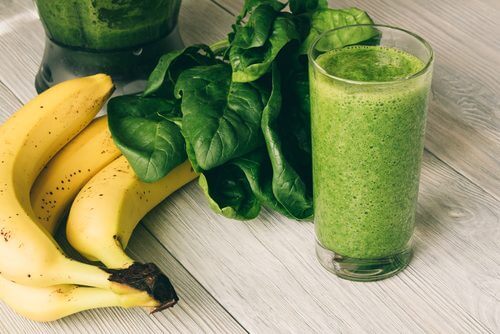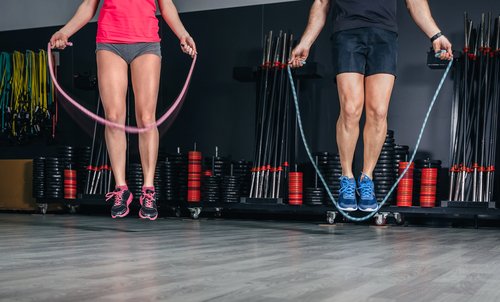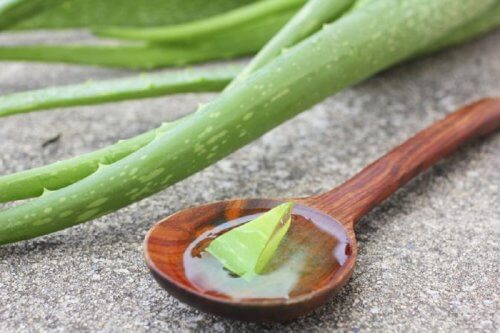Loose Skin After Losing Weight? 7 Tips to Firm Up


Written and verified by psychologist Valeria Sabater
Have you ever lost weight in a very small space of time? If so, you might have noticed that you now have some loose skin, especially around the arms and stomach.
Loose skin after weight loss is a common problem. It normally occurs when we lose a lot of weight within a very short time frame. Sometimes, it happens so quickly that the skin doesn’t have enough time to adapt to your new physical condition.
So, if you want to lose a few extra pounds, it’s important to stay away from so-called “miracle” diets. We would recommend losing body fat in a controlled and healthy way. By this, we mean eating a balanced diet, and choosing the right physical exercises.
Needless to say, this will take some time. However, if you want to avoid loose skin, it’s best not to rush things.
However, if for some reason you still have loose skin, don’t worry! There are ways you can reduce loose skin without having to resort to surgical intervention.
With the right strategy, you can help tone your skin. Broadly speaking, this will involve regular physical exercise and a healthier diet. In this article, we’ll give you all the information you need to help combat loose skin after weight loss.
1. Get enough protein

Our first tip for treating loose skin after weight loss isn’t to eat more fruit and veg. Instead, what you really need is protein. Proteins are the only nutrients that can nourish muscle and skin tissue and help it heal.
This protein can be animal or plant-based. However, it’s best to opt for lean meat –it’s healthier and better for toning up loose skin.
These are your best options:
Do you like this article? Discover: Keys to Lose Weight Without Starving Yourself
2. Drink plenty of water
It’s not about getting in the mandatory 8 glasses of water a day. It’s simply a question of keeping yourself hydrated.
Here are a few pieces of advice that might make things easier for:
- Something as simple as sipping water every half hour can help you maintain the level of hydration your body needs to function properly.
- It doesn’t just have to be water – you can also alternate between other healthy drinks. Good options include tea or fruit-infused water.
Keeping yourself hydrated is fundamental for repairing your skin.
3. Jump rope

As we mentioned at the beginning of this article, if you want to fight loose skin after losing weight, you’ll need to do exercise. However, it’s not just about doing any exercise. You’ll need high-impact exercise routines to help strengthen your muscles.
- Start with a few simple exercises. As time goes on and your body condition improves, you can start to increase both the intensity and the number of repetitions. Pushing yourself too hard could have a detrimental effect on your health.
- One particularly effective way to tone muscles is to use a jump rope. Once you’re fit enough, you can try doing two 15-minute sessions. This high intensity activity will require a lot of effort on your part, but the results will be worth it.
4. Cinnamon infusion with honey
Cinnamon is a great antioxidant, helping to protect bones and muscles from the effects of free radicals.
- One tasty way to start the day is to make yourself a simple cup of cinnamon tea with a bit of honey. Try to use organic honey that has no added sugar.
- Drink this traditional remedy first thing in the morning, at least 30 minutes before breakfast. It will help you in your efforts to firm up loose skin after weight loss.
5. Aloe vera

Aloe vera can have many benefits for your health. In fact, we keep discovering more benefits of this medicinal plant. However, what many people don’t know is that it’s also great for treating loose skin after losing weight.
Aloe vera is one of the best moisturizers and healers of damaged skin. The many antioxidants, vitamins, and minerals contained in aloe vera are even great for treating stretch marks.
- To take advantage of it, all you have to do is massage the area with aloe vera gel every day.
- Let it sit for a few minutes.
- Then, rinse with warm water.
Discover: 6 Exercises for Fighting Flabby Legs
6. Strength training to treat loose skin after losing weight
The exercise below is perfect for firming up loose skin. To do it, you’ll need to make a real effort with this one, and be sure to set aside sufficient time for this workout.
The exercises you do should be designed to increase muscle tone. This is a good way to strengthen the skin’s connective tissues, and allow it to gradually adapt to your new weight.
Weight-lifting is one of the best ways to tone up after weight-loss.
- If you decide to go to the gym to work out, the instructors will be able to teach you how to work these key areas without hurting yourself. They’ll also ensure you don’t lift too much before you’re ready, which can cause serious damage to the joints.
- If you want to lift weights at home, do so with care and be sure to respect your limits. Also, try to work both your arms and abs by combining weight-lifting with other exercises.

7. Foods to help your body produce collagen and elastin
To repair loose skin after losing weight, you’ll have to give your body all the nutrients it needs. This will help it recover its natural firmness and elasticity.
To do this, you need to eat foods that will help your body synthesize collagen and elastin – two elements which are essential for healthy skin.
Here’s a list of some of the best foods you can incorporate into your diet to help repair your skin:
- Tofu
- Soy
- Carrots
- Salmon
- Yogurt
- Nuts
- Kale
- Arugula
In conclusion, it’s important to remind you that when it comes to losing weight, it’s always best to do it in a controlled and healthy way. Take your time, and stay away from excessively restrictive diets. They almost always have negative side effects on your health.
Loose skin is just one of these negative side effects. However, if you follow these tips consistently, you can get back the firmness and elasticity you want.
All cited sources were thoroughly reviewed by our team to ensure their quality, reliability, currency, and validity. The bibliography of this article was considered reliable and of academic or scientific accuracy.
Drake, R.L. (2006). Gray’s Anatomy para Estudiantes. New York: Elsevier.
Kierszenbaum, A. L. (2006). Histology and Cell Biology. St. Louis: Elsevier.
Schiffman, H. (2001). La Percepción Sensorial. London: Limusa Wiley, p. 153.
This text is provided for informational purposes only and does not replace consultation with a professional. If in doubt, consult your specialist.








